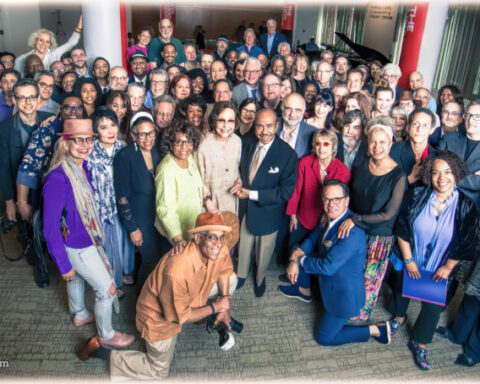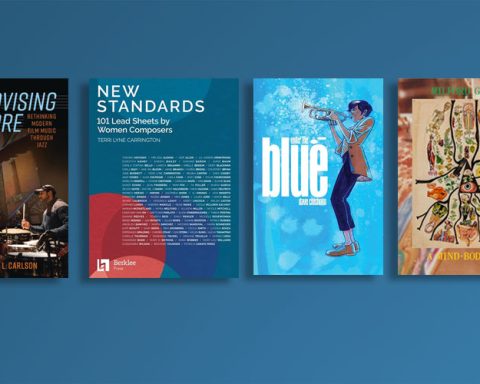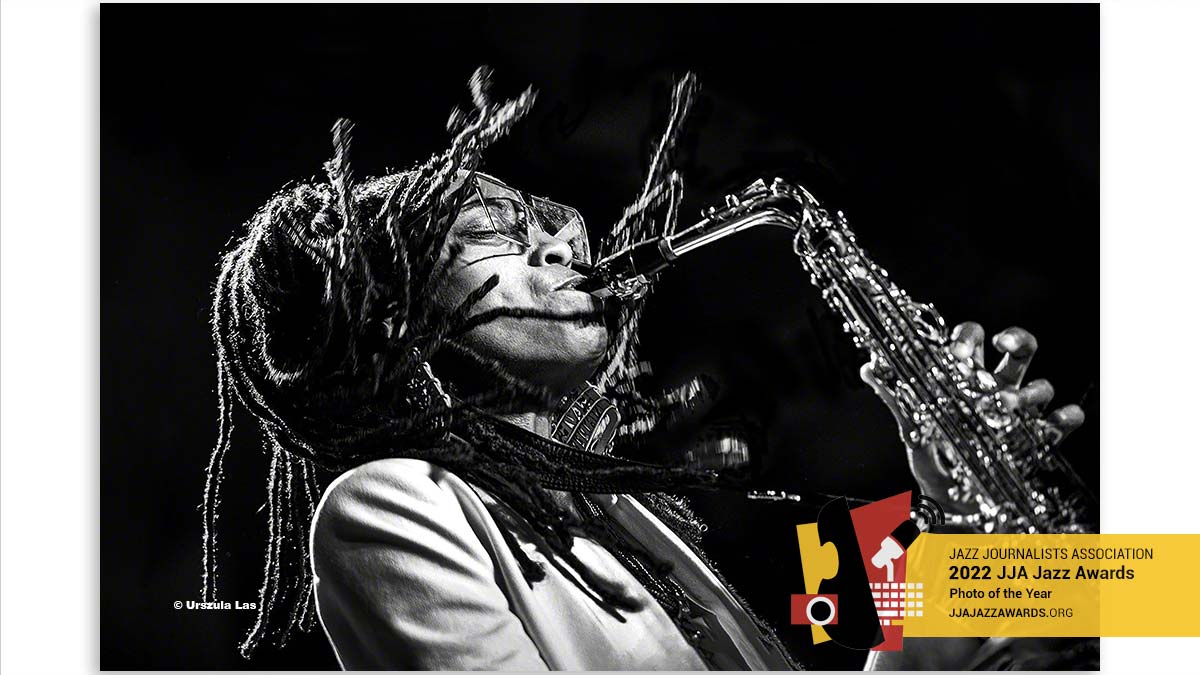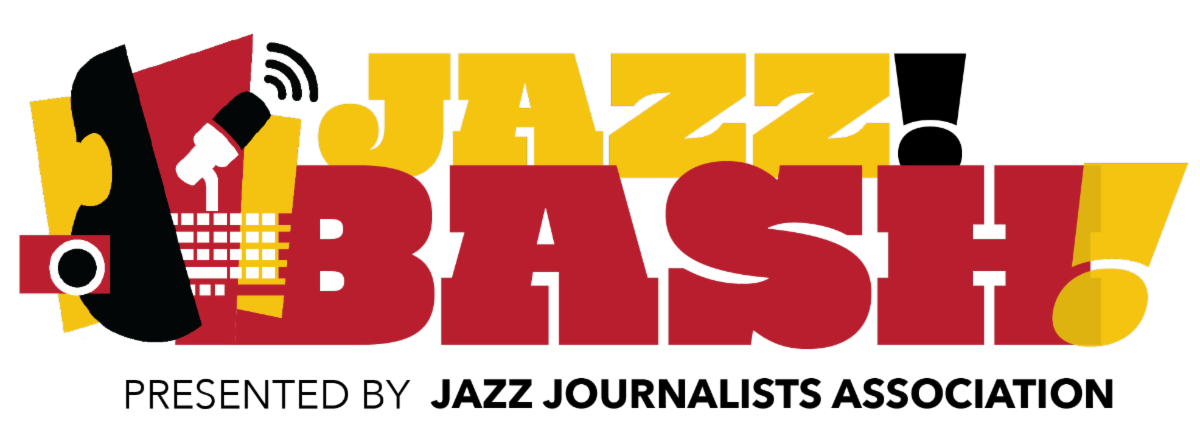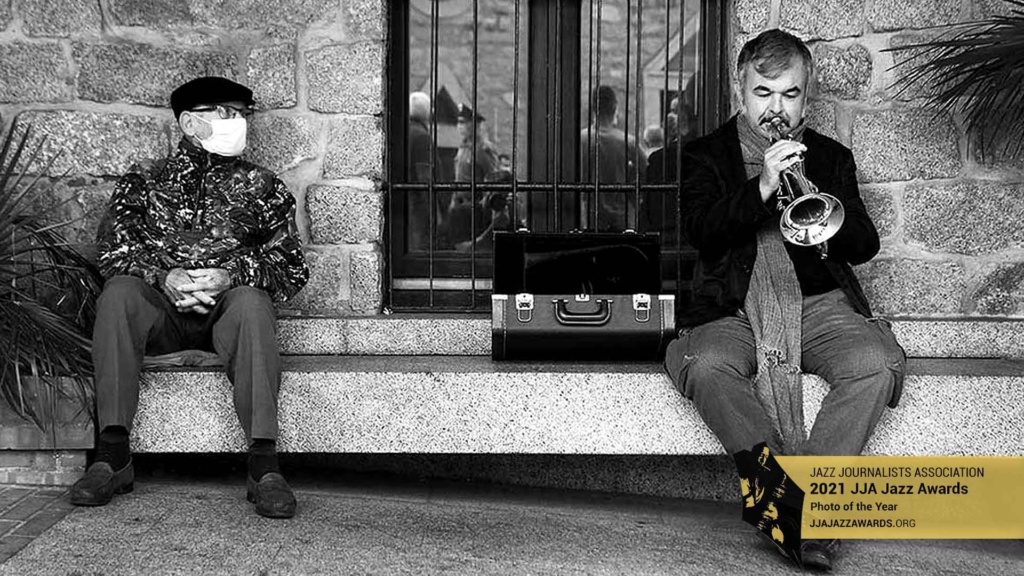Over the course of three decades, the Jazz Journalists Association has developed from being a loose coalition of like-minded professional writers, photographers and broadcasters to a 501 (c) (3) non-profit with global outreach through its online programs and community-based initiatives. W. Royal Stokes, a founding member of the JJA, detailed the JJA’s history in 2013. Updates from Howard Mandel at the original post’s end.
The seeds of the Jazz Journalists Association (JJA) were sown in a series of meetings that commenced in 1986.
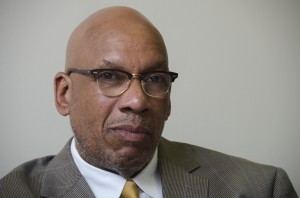
They took place in Chicago and New York and were initiated by Willard Jenkins, Paul Baker, Art Langeand Howard Mandel. Paul would go on to edit the JJA’s newsletter Jazz Notes, Art would be chosen as its first President, Howard would succeed Art in 1996 and Willard would succeed Nancy Ann Lee as Vice President that year.
“Our organization was founded at the Arts Midwest Jazz Media conference at the University of Illinois-Chicago in ’88,” Willard explains. “I produced that conference as part of my responsibilities as Jazz Program Coordinator at Arts Midwest, with assistance from Wayne K. Self of the Arts Midwest staff. The intent of the conference was to host a sort of think-tank of jazz media — focusing on our nine-state sector of the Midwest — towards the potential development of some form of collective, or formal organization, of both jazz print and jazz radio media towards the further development and betterment of each profession.
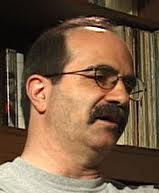
Howard Mandel and Art Lange were two of the panelists we engaged for this series of panels and discussions. We hosted one plenary session with both print and radio and subsequent break-out sessions for each sector.”
“The importance of Paul Baker in the founding and sustaining of the JJA in its early days should not be underestimated,” says Art. “In the spring and summer of 1988, Paul, Howard, Willard, and I began contacting journalists with information and follow-up questionnaires. By July 1988 membership dues were beginning to come in to the volunteer treasurer Janis Lane-Ewart. There was a meeting of interested parties at the Jazz Times convention in October. By spring 1989 the organization was up and running, and the first issue of Jazz Notes was published, with Paul Baker as editor, and me as consultant.
“Formal and informal meetings continued to take place at jazz festivals and pretty much anytime more than a handful of writers could get together,” Art continues. “The newsletter was the primary focal point of the organization. It wasn’t until September 1992 that an election by mail took place, and I was elected the first President, Nancy Ann Lee, Vice-President, with Paul Baker and Janis Lane-Ewart running unopposed for Secretary and Treasurer, respectively. I served as President until 1996, did not run for re-election, and Howard ran unopposed for President in our second election.”
With stated goals to promote high standards and respect for jazz writers’ works, to create a professional network and to increase general interest in jazz, the Jazz Journalists Association was the first such international organization. Beginning with writers from Down Beat, JazzTimes, Jazz Forum and other publications, it soon added jazz broadcasters, photographers, filmmakers and graphic artists.
Through the pro bono efforts of attorney Steven H. Robinson with assistance of newly elected treasurer Arnold Jay Smith and tax

accountant Richard Terrano, the JJA incorporated in the state of New York in 2004 as a non-profit 501 (c) (3). It also reached out to musicians, educators and those in the industries of record producing, publicity and management, offering to them non-voting membership at a slightly higher fee than the voting membership. A reduced-fee membership has been made available to students.Presently, the JJA membership includes contributors to most jazz publications, authors of books on jazz subjects, widely published and exhibited photographers, internationally recognized broadcasters, bloggers, videographers and pioneers of jazz in cyberspace. The JJA membership as of May 2013 stands at 244 voting members and 51 non-voting, with more than 1000 registered “contacts” and affiliations with organizations such as Jazz at Lincoln Center, the Jazz Educators Network, SFJazz, the Jazz Institute of Chicago, Jazz Boston, Berklee College of Music, Cornish School of the Arts, and so on.
In addition, the JJA has developed working relationships with dozens of unaffiliated colleagues, convened nearly 100 participants in its 2011 eyeJAZZ video training program (15 webinars of which remain accessible in archived form for free, online), assembled a “Media Network” and generated “satellite parties” in association with its Jazz Awards, Jazz Heroes and (this year) its JazzApril initiatives which stimulate community involvements that work towards the organization’s original goals.
The JJA has held annual meetings, often in conjunction with major festivals and jazz conferences, in New York, San Francisco, Chicago,

Cleveland, Montreal, Washington, D.C., Newport RI, Portland OR and New Orleans. Beginning in January 2001 the JJA hosted workshops and panel discussions at the International Association for Jazz Education (IAJE) conventions in New York, New Orleans, San Francisco, Monterey, Chicago, Long Beach CA. Among the topics discussed were discrimination against women instrumentalists and journalists, negotiation of payment for electronic copyrights, critics’ clinics (“Who Asked You Anyway?” instructional panels initiated by Mandel, advanced by Paul de Barros and Dan Ouellette, with many members participating as “mentors”) and availability of health insurance, which members were able to acquire for a time though the JJA’s associate program with the National Writers Union.
In 2009, ’10 and ’11 the JJA held mini-conferences comprising panels, hands-on workshops and Town Hall meetings at the New York convention of the Association of Performing Arts Presenters (APAP); in ’11 and ’12 it co-hosted parties with NPR Music, as kickoffs to New York City’s popular WinterJazz Festival. For three years in the mid 2000s, the JJA held monthly “Jazz
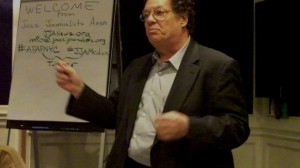
panel at APAP 2012
Matters” panel discussions at the New School Jazz program’s performance space in Manhattan, where the general public, students, teachers and members have discussed hot jazz topics, held critics’ listening tests, and so on. The organization’s officers and members have also created enrichment programming for jazz festivals (Newport, PDX in Portland OR, Chicago, Monterey), consulted arts agencies and funders (including the Doris Duke Charitable Foundation and Jazz Arts Group, Columbus OH), mentored budding journalistic talents, hailed new artists and labored to document jazz as it happens.Since 1997, the JJA has annually presented Jazz Awards for excellence in music and music journalism. Originally the presentations were made at gala fundraising events in June in New York (videos from these Awards galas are posted on Youtube). In 2013, the JJA announced winners of the musicians categories of its Jazz Awards on May 1, with presentation of the physical Awards planned for winners’ professional appearances throughout the U.S., and scheduled a June event to announce the Awards winners in journalism categories.

George Wein, foreground
Josh Jackson onstage
The JJA has published compilations of members’ self-selected best articles and maintains an up-to-date members’ database. Jazz Notes, which began as the JJA’s quarterly newsletter, was in print form from its debut in the spring of 1989 until the Autumn issue of 2007 when it went online. Jazz Notes was, for its first two years of existence, a modest four-to-eight page publication, serving as a clearing house of ideas and news. In 1992 it began to take on the form and substance of a journal, running from 16 to 32 pages and introducing, for example, book reviews; a News of Members feature; Letters to the Editor; columns by members (including Willard Jenkins, Ken Franckling and myself); tribute profiles of deceased members and prominent jazz figures; coverage of festivals, club gigs and jazz industry meetings; regular reports by the association’s president and an annual obituary list of musicians, writers and others of the jazz world. The successive editors of Jazz Notes were Paul Baker (1989-1991), W. Royal Stokes (1992-2001), David Franklin (2001-2003) and David Adler (2003-2010). Other particularly significant contributions were made by membership secretaries Paul Blair and Jerry D’Souza.
After the Winter 2010 online issue Jazz Notes was replaced as the “public face” of the JJA by JJA News, designed and webmastered by Forrest Dylan Bryant (who had come to the organization for one of its “Who Asked You, Anyway?” clinics). David Adler was the first editor of JJANews; upon his resignation due to new family and teaching responsibilities in 2011, Howard Mandel took over the editorship on an interim basis. The JJA continues to search for a JJA member to take charge of JJANews in exchange for a modest honorarium.
Inaugurated in 1996, the JJA’s first website JazzHouse.org, under the direction of Whit Blauvelt, featured members’ writings and photography, member news and the association’s activities. With its series of “Postcards” — brief reports from the field — JazzHouse anticipated a now broadly accepted format for online writer: the blog, and maintained, thanks to the efforts of Kenny Mathieson and Todd S. Jenkins, an authoritative obits column “The Last Post.” JazzHouse remains an archive of those materials.

However the Jazz Journalists Association Member Site/Office, created and webmastered by JJA media director Jo Ann Kawell, is the active and official base for all organizational JJA activities. Jo Ann has also been responsible, since 2010, for the creation of websites for JJA projects including the video training series eyeJAZZ, www.JJAJazzAwards.org, www.JazzApril.org, the JJA’s Youtube, UStream and Vimeo accounts, and its powerful, multi-pronged social media presence on Facebook and Twitter (@jjanews, @eyejazz, @jazzapril, @jjajazzawards). In 2012 Susan Brink, an eyeJAZZ trainee, joined the JJA staff as development director.
Highlights and milestones of the JJA’s 25-year history can conveniently be tracked in Jazz Notes and JJA News. Clearly one of the most significant to the JJA, as well as to every other communications user or entity, was the creation of the Internet. After all, as Bob Dylan sang a half-century ago, “For the times they are a-changin’,” and no greater change has come to the world of publication since Johannes Gutenberg’s invention of printing in 1450.
Lee M. Cohen, writing in Jazz Notes in 1995, expressed the hope that his essay would be first in “a series of salvos aimed at awakening jazz journalists and the greater jazz community to the challenges presented by the coming information age,” adding, “1995 will be the year the jazz lane on the information superhighway is paved.” Consciously or unconsciously, Lee was echoing Swiss conductor Ernest Ansermet’s 1919 observation that Sidney Bechet’s “way is perhaps the highway the whole world will swing along tomorrow.”
Two issues later, in my “From the Editor” column, I noted that four of the 10 articles submitted for the issue in hand came by email and observed, “Come 2000 A.D. . . . the writer without electronic wings will be the lonely exception. Think back, say five years, and ask yourself if you then so much as knew what a modem was. I sure didn’t!”

recipient of JJA Lifetime Achievement in
Jazz Journalism Award, 2014.
Photo by Erika Hartmann Stokes.
In subsequent years, many, many articles appeared in Jazz Notes and JJA News by James Hale, Paul Baker, Howard Mandel and others on the challenges, opportunities and functions of the Internet, all the way up to, for example, media director Kawell’s advice via the JJA MEMBERS Discussion Group in March 2013, “JJA Twitter-ers– Please ‘follow’ Jazz April @jazzapril_jja and RT (and talk back to us) whenever you can. Help us spread the word about Jazz April. (If you don’t know about it yet: http://jazzapril.com/ ).” What would anyone have been made of Jo Ann’s suggestions only a few years ago? To cite another example of cyberspeak, what dictionary a decade ago would have included the term “webinar,” referring to an online forum of the kind the JJA now hosts monthly on such subjects as guidelines for writing jazz musician biographies, starting and fine-tuning blogs and the thorny issue of whether digital downloads are acceptable for review?
Another leap forward took place with the first Critics’ Choice Jazz Awards polling of JJA members in 1997, followed the next year by its initial in-person-presentation gathering, in June, at Alice Tully Hall and a subsequent celebratory cocktail party at Iridium jazz club. The JJA took over complete responsibility for the Jazz Awards in 1999.
In his “Jazz Awards 2001” article in that year’s fall issue of Jazz Notes, Howard enthused of the Jazz Awards party at Birdland, “Lionel Hampton was there . . . in a wheelchair [receiving] a very spontaneous standing ovation from the 250-some JJA members, musicians, jazz movers and shakers, and enthusiasts gathered to benefit the Jazz Foundation of America’s Musicians Emergency fund and announce winners of the JJA’s fifth annual polling of jazz writers, broadcasters and photographers worldwide in celebration of individuals’ achievements in music and music journalism.”
In his “President’s Report” of the same issue, Howard presciently reveled in the “unprecedented success of Jazz Awards 2001 . . . which raised the JJA’s profile and reputation in New York-based circles and, we believe, much farther afield, as its news has been reported on the Web and in all the major jazz publications.”
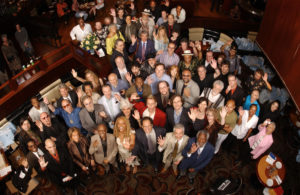
by Gene Martin
The event has continued, always in June, being held at South Street Seaport, the Knitting Factory, B. B. King’s Blues Club and Grill, the Jazz Standard, City Winery and the Blue Note Jazz Club, and has attracted large audiences of luminaries from within and without the jazz community. Masters of Ceremonies have included David Letterman’s musical director Paul Shaffer, comedian and Civil Rights activist Dick Gregory, actors Avery Brooks and Robert Wisdom, radio programmers Josh Jackson, Terrance McKnight and blogger Tanya Ellerbee. Comics and jazz devotees Soupy Sales, and Al “Grandpa Munster” Lewis have addressed Awards party attendees; one year critic and author Stanley Crouch played a drum solo. In 2010 and 2011 the Jazz Awards event was streamed live online.
Musical groups performing at the Jazz Awards have included the big bands of Bobby Sanabria and Charles Tolliver, Tia Fuller’s Quartet, Marc Cary’s Focus Trio, Rale Micic’s trio, Randy Weston with T.K. Blue and Candido Camero, Ayako Shirasaki, Wallace Roney’s sextet, Gregory Porter, Matt Miller’s quartet, the Hammer Klavier Trio from Hamburg, Germany, Doug Wamble, Nnenna Freelon, Dewey Redman’s trio (with Matt Wilson) and quartet, the Renee Cruz New School Jazz Band, Stanley Crouch solo, Cassandra Wilson, Dave Douglas’ quintet, TC3, Sheila Jordan, Judy Bady, Igmar Thomas and the Cypher, Roberta Piket’s trio, Ben Allison’s quintet, Sy Johnson’s Octet, and duos of Marian Petrescu and Andreas Öberg, Gabriel Marin and John Ferrara, Carol Sudhalter and Daryl Sherman, Joe Lovano with Roswell Rudd and with Hank Jones, Paulette McWilliams and Nat Adderley Jr., Roseanna Vitro and Mark Soskin, Christian Scott and Sean Jones, and Jane Bunnett with Hilario Duran as well as with her quintet.
In addition to the musician and journalist recipients of awards, an “A Team” of activists, advocates, altruists, and aiders and abettors of jazz have been honored since 2001, in 2010 morphing into the category “Jazz Heroes.“ These have educators, health care providers, jazz community organizers, record producers and

record company executives, club owners, festival presenters, principals of the Jazz Foundation of America, NEA chairman Dana Gioia, HBO series producer-writers, philanthropists, veteran publicists, JJA vice president Yvonne Ervin and (in 2013) Willard Jenkins, among many others. Here is the complete list of A Team members and Jazz Heroes designates.
JJA President Howard Mandel, who conceived the idea for the annual celebration, deserves major credit for the continuing success of the Jazz Awards, for he has put much time and enormous energy into administering it. However, he does not do this alone, and credits Jo Ann Kawell, Susan Brink, publicists Jim Eigo, Don Lucoff and Kim Smith, vps Yvonne Ervin (and her husband Alan Hershowitz) and James Hale, videographers Michal Shapiro and Byron Speight and Ilan Lieman of IBCreative, volunteers Colleen Growe, Joseph Petrucelli, Joan Watson-Jones, Judy Balos, Lois Mirviss, associate producer Mehgan Stabile, stage manager Bridget Sullivan, fundraiser Shannon Gibbons, photographers Enid Farber, Andrew Lepley, Fran Kaufman and the late Gene Martin, club owner/operators Steve Bensusan, Michael Dorf and Seth Abramson among many others for significant help in bringing the Awards galas to fruition.
Due in part to the high profile of the galas, which have been reported on by the Associated Press, the New York Times, et al., the JJA is sometimes thought of as being New York-centric, but the organization has taken pains to decentralize its programming as much as resources allow. For instance, Los Angeles-based JJA board member Fred Jung produced an extraordinary Jazz Awards party at the Jazz Bakery in 2005, when the JJA was one of five professional organizations involved in the first National Critics Conference (to which it sponsored its first class of Clarence Atkins’ emergent jazz journalists for five days of career enrichment programs). That party was entertained by no less than pianist Freddie Redd’s trio, Joe McPhee solo, trumpeter Bobby Bradford’s Sextet, multi-reedist Vinny Golia’s electric ensemble, vocalist Dwight Trible’s band and attended by (among others) Kenny Burrell, Charlie Haden, Gerald Wilson, Dr. Craig Springer and Wadada Leo Smith — all honorees.
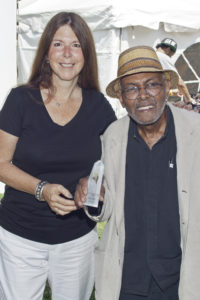
2012 Lifetime Achievement
in Jazz Journalism honoree
Amiri Baraka
As the JJA’s activities have increasingly embraced the interactive and widely communicative possibilities of the internet, it has been continuously innovative in creating functional formats. In the early ’00s, Jazzhouse had unique software that allowed for real-time multi-user forums about topics including “what is Latin jazz?,” “writing the jazz biography,” “jazz and fiction.” Attempts were made to include the JJA’s members in Europe, Asia and Russia — where there has been an ardent affiliated chapter comprising as many as a dozen jazz journalists, including Cyril Moshkow, editor/publisher of Jazz.RU — in these events, though the time difference has proved a difficult stumbling block to simultaneous conversations.
In 2011, the JJA’s eyeJAZZ project, the result of its first successful grant, was more successful at involving a wide-spread participant base. Funded by the Jazz.NEXT initiative of Mid Atlantic Arts Foundation (through the generous support of the Doris Duke Charitable Foundation), the eyeJAZZ offer of pocket-sized video cameras and extensive group and one-to-one instruction in conception, shooting, editing and distribution of localized short-form jazz news stories from videographer Bret Primack, filmmaker/photographer Floyd Webb, Jo Ann Kawell and Howard Mandel. It attracted almost 200 applicants from around the world. Cameras were eventually bestowed on 35 participants including one in India, and more than 60 “attended” the 15 online training sessions, from which more than 200 videos were produced — and a new genre of jazz journalism was born.
As an example of its current outreach efforts, I point to the JJA’s 2013 launching of JazzApril 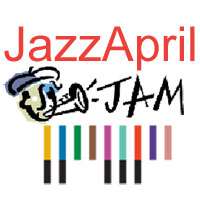 (www.jazzapril.com/), a pro bono multi-platform media campaign to foment media attention to jazz in coordination with the Smithsonian Institution’s Jazz Appreciation Month initiative and its culmination, International Jazz Day on April 30, both endorsed by the U.S. Conference of Mayor’s. Susan Brink coordinated 25 JazzApril parties in two dozen American cities plus Ottawa, in honor of the JJA’s 2013 class of locally-chosen Jazz Heroes.
(www.jazzapril.com/), a pro bono multi-platform media campaign to foment media attention to jazz in coordination with the Smithsonian Institution’s Jazz Appreciation Month initiative and its culmination, International Jazz Day on April 30, both endorsed by the U.S. Conference of Mayor’s. Susan Brink coordinated 25 JazzApril parties in two dozen American cities plus Ottawa, in honor of the JJA’s 2013 class of locally-chosen Jazz Heroes.
As it enters its 26th year of activity, the Jazz Journalists Association has produced its 17th Jazz Awards. With winners of its musical categories already announced online, the June party will feature the announcement of winners of Awards in journalistic categories. A ticketed public event, the 2013 JJA Jazz Awards party will be held at the Blue Note Jazz Club on June 19, from 4 to 6 pm.
In the course of its initiatives, the JJA has enjoyed the support of ASCAP and BMI, Absolutely Live, Arkadia Jazz, Alma Records, Berklee College of Music, Blue Note Records, Brother Thelonious Belgian Style Ale (from North Coast Brewery), Clean Feed, Columbia Legacy, Concord Jazz, DL Media, the Detroit International Jazz Festival,

w/ Jazz Hero Jeff Haskell
ECM Records, Fully Altered Media, George Wein’s Festival Productions, HIP Health Care of New York, Hot House magazine, Jazz@Lincoln Center, the Jazz Gallery, the Jazz Institute of Chicago, Jazz Promo Servicees, the Knitting Factory, Latin Percussion, Mack Avenue Records, Monterey Jazz Festival, New England Conservatory, the New School Jazz and Contemporary Music program, the New York City Jazz Record, Palmetto Records, Resonance Records, Tico Drums, Third Floor Media, Tower Records, Universal Music Group, SFJazz, Tekserve, Virgin Megastore and many other organizations.
For more details on the history of the JJA, consult back issues of the online Jazz Notes (available at http://news.jazzjournalists.org/jazz-notes/) and peruse the archives of JJA News and JazzHouse.org. The Performing Arts Library at Lincoln Center has in-print Jazz Notes issues from the publication’s initial number in 1989 to 2000 for use in-library only.
Please spread the word about the Jazz Journalists Association to your jazz writing, broadcasting, photographing and new-media-producing friends and professional associates, musician acquaintances and jazz industry contacts, and encourage them to join. Modest annual dues are tax deductible.
The JJA continuously seeks new members pursuing the profession and support members who do not vote but receive all other benefits. The JJA also welcomes contact with other associations of independent artists, critics, educators and journalists.
# # #
In the seven years since W. Royal Stokes wrote his overview, the JJA has continued to experiment with new media as a communicative tool, and to evolve. The Jazz Awards were presented for several years at NYC’s Blue Note Jazz Club, documented by videographer Michal Shapiro on the JJA’s YouTube channel.
At the New School in 2018, at a time of long-deserved attention to diversity (or the lack of it) in the art form, ten women were Awards winners (Maria Schneider won in three separate categories), and 16 men, of African-American and European ancestry, Puerto Rican, Indian and Malaysian/Australian backgrounds, ages 89 (Benny Golson) to 27 (Jazzmeia Horn). Writer-historian Patricia Willard became the first woman the JJA has celebrated with an Award for her Lifetime Achievement in Jazz Journalism. (From their start JJA’s honors for yearly achievements in writing, broadcasting and photographer have been co-named for women: Helen Oakley Dance, Marian McPartland and Lona Foote, respectively.)
The JJA Jazz Heroes campaigns continue with Awards presentations, official proclamations, community gatherings when possible and increased media visibility for the people who keep the jazz ecosystem afloat. Nominations for Jazz Heroes are accepted from local jazz enthusiasts willing to volunteer work to honor those nominees, vetted and conferred by the JJA board.
To celebrate the 2020 Jazz Awards, when no in-person gathering was possible, the JJA convened an extraordinary group of the year’s winners in a Zoom production. Six panels of instrumentalists and vocalists discussing the day’s hot topics, moderated by JJA’s journalist Awards winners, presented a historic picture of accomplished artists reacting to a pandemic that affects everything about their livelihoods.
Among other JJA postings on the Youtube channel is the webinar series Talking Jazz, with media and journalist specialists talking about changes and challenges in coverage and presentation of music and arts criticism.
In 2020 the JJA renewed efforts to engage journalists internationally, with an active Slack discussion suite instigated by Alex Rodriguez. Although action on that platform lapsed, it resulted in JJANews JazzOnLockdown and Jazz Rebounds reports about jazz business responses to virus-related shutdowns from Australia and New Zealand, Berlin, British Columbia, Peking, Havana, Athens, the Netherlands, Norway, Tel Aviv, Romania, Madrid and the UK as well as the Bay Area, Chicago, Cleveland, the DC-Philadelphia-Baltimore axis, Indianapolis, Tampa, and elsewhere.
Social media for the JJA is currently managed Leslie Lynnton Fuller. Michael J. West handles Members Updates. In 2020 Sammy Stein, based in London, was named International Editor of JJANews. Following Jo Ann Kawell’s retirement in 2018, Melanie Nanez has become the JJA’s webadmin. As of November 2020, the JJA’s board comprises Bob Blumenthal, Susan Brink, Andy Gilbert, Janis Lane-Ewart, Carolyn McClair, Don Palmer and Paul Rauch.



